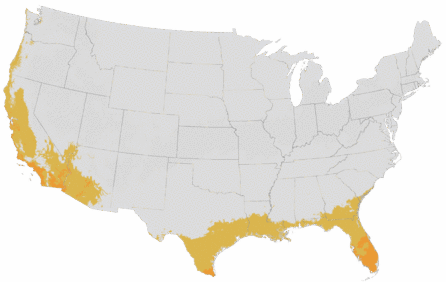You're growing in this Zip Code:
Change LocationDiscover Plants for Your Area
Tequila Sunrise Mirror Plant
Coprosma hybrid 'Tequila Sunrise' PP #18,392
Retailers Near You
No Retailers found within 50 miles of your zipcode
Be Inspired: How to Use this Plant
| Bloom Time | Inconspicuous; prized for foliage. |
|---|---|
| Deciduous/Evergreen | Evergreen |
| Special Features | Dramatic Foliage Color, Easy Care, Fall Color, Waterwise |
| Problems/Solutions | Coastal Exposure |
| Growth Rate | Moderate |
| Growth Habit | Pyramidal |
| Patent Act | Asexual reproduction of plants protected by the Plant Patent Act is prohibited during the life of the patent. |
| Landscape Use | Border, Container, Hedge, Accent |
| Design Ideas | Looks best in group plantings and magnificent when combined with succulents. |
| Foliage Color | Multicolored |
| Companion Plants | Rose of Sharon (Hibiscus syriacus); Speedwell (Veronica); Euryops (Euryops); Cordyline (Cordyline); Purple Fountain Grass (Pennisetum) |
| Care Instructions | Grows easily in average to poor, neutral to slightly acidic, well-drained soils. Water deeply, regularly during the first growing season to establish an extensive root system; once established, reduce frequency. Feed with a general purpose fertilizer before new growth begins in spring. For a tidy, neat appearance, prune annually to shape. |
| Lore | Across the South Pacific in Australia, New Zealand, and Borneo are about 60 species of this shiny leaf shrub. The genus was classified by the German, Johann Reinhold Forster in the late 18th century. Some species of Coprosma carry an unusual "catty" odor which led Forster to derive this genus name from the Greek for a fetid smell. One of the most famous collectors of Coprosma species was I. Bauer, who traveled New Zealand in 1804-1805. In the South Pacific and New Zealand, indigenous peoples use the wood and inner bark of coprosma as a yellow dye that requires no mordant. The leaves are used for an antibacterial wound poultice. Seeds are ground as a coffee substitute. |
| Bloom Time | Inconspicuous; prized for foliage. |
|---|---|
| Deciduous/Evergreen | Evergreen |
| Special Features | Dramatic Foliage Color, Easy Care, Fall Color, Waterwise |
| Problems/Solutions | Coastal Exposure |
| Growth Rate | Moderate |
| Growth Habit | Pyramidal |
| Patent Act | Asexual reproduction of plants protected by the Plant Patent Act is prohibited during the life of the patent. |
| Landscape Use | Border, Container, Hedge, Accent |
|---|---|
| Design Ideas | Looks best in group plantings and magnificent when combined with succulents. |
| Foliage Color | Multicolored |
| Companion Plants | Rose of Sharon (Hibiscus syriacus); Speedwell (Veronica); Euryops (Euryops); Cordyline (Cordyline); Purple Fountain Grass (Pennisetum) |
| Care Instructions | Grows easily in average to poor, neutral to slightly acidic, well-drained soils. Water deeply, regularly during the first growing season to establish an extensive root system; once established, reduce frequency. Feed with a general purpose fertilizer before new growth begins in spring. For a tidy, neat appearance, prune annually to shape. |
|---|
| Lore | Across the South Pacific in Australia, New Zealand, and Borneo are about 60 species of this shiny leaf shrub. The genus was classified by the German, Johann Reinhold Forster in the late 18th century. Some species of Coprosma carry an unusual "catty" odor which led Forster to derive this genus name from the Greek for a fetid smell. One of the most famous collectors of Coprosma species was I. Bauer, who traveled New Zealand in 1804-1805. In the South Pacific and New Zealand, indigenous peoples use the wood and inner bark of coprosma as a yellow dye that requires no mordant. The leaves are used for an antibacterial wound poultice. Seeds are ground as a coffee substitute. |
|---|
Retailers Near You
No Retailers found within 50 miles of your zipcode
Retailers Near You
No Retailers found within 50 miles of your zipcode
Buy Online
This plant is not available to purchase online.
We no longer grow this plant. For replacement suggestions, check out the plants “You May Also Like” below.
About Us
We have been pioneers and craftsmen in the art of growing plants for nearly
100 years. Since our founding in Southern California by Harry E. Rosedale, Sr.
in 1926, we have been absolutely dedicated and obsessed with quality.
We have been pioneers and craftsmen in the art of growing plants for nearly 100 years. Since our founding in Southern California by Harry E. Rosedale, Sr. in 1926, we have been absolutely dedicated and obsessed with quality.





